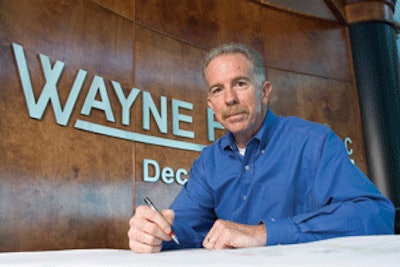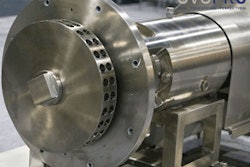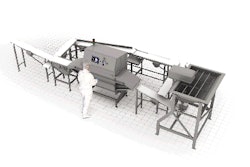
Take a stroll down the frozen-dinner section of any grocer's freezer case and it is likely that the chicken in many of the meals there was produced by Wayne Farms LLC. It may not be a household name due to its marketing approach, but Wayne Farms is a powerhouse in industrial sales of further-processed chicken. Now the company has added to its capacity to produce fully-cooked wings with a new further-processing line at its facilities in Decatur, Ala.
Wayne Farms' further-processing complex in Decatur, which is devoted to producing fully-cooked chicken products, comprises two further-processing facilities and a freezer storage facility under construction. The Decatur East facility, which was built in 1997, includes six fully-cooked lines producing around 120 million pounds annually. The Decatur West facility, which opened in 2006, operates three fully-cooked lines, with the newest wing production line started this year. Each of the Decatur West lines produces about 20 million pounds annually. A freezer facility, which is scheduled to be up and running soon, will consolidate the product from the two further-processing facilities for shipment in truckload quantities. Inputs for the Decatur further-processing lines mainly boneless breasts, wings and tenders come primarily from three supply plants, one of which is located adjacent to the Decatur further-processing facilities. The business requires more tenders than can be produced in the three slaughter facilities, so additional tenders are provided by two other Wayne slaughter facilities. Wayne Farms operates eight slaughter facilities in the southeastern United States.
All chicken produced at the Decatur further-processing facilities is fully cooked. Products mainly comprise diced meat, breaded patties, tenders and wings. Strips, nuggets and chunks are produced in lesser volumes, along with a limited quantity of fillets.
Business segments served from the Decatur facilities include industrial accounts, quick-service restaurants and casual-dining chains. Wayne began an expansion into the retail sector two years ago, and the Decatur facilities are equipped to handle production of fully-cooked product for this sector.
New line set up for cooked wings
Decatur West's newly opened line, referred to by the company as Line 53, is designed to produce fully-cooked wings, though other products can be produced on it. Stan Hayman, director of marketing and business development for Wayne Farms, said, "We want to significantly expand our fully-cooked wing business."
While the new line is based on marketplace needs, Hayman said that all the further-processing lines are designed to achieve maximum throughput and efficiency. "That comes from the kinds of products put on the line, their loading and how raw materials are fed into the system," he explained.
The facilities and the new wing line incorporate the latest in technology and design. The facility is highly automated; very little manual labor is required. Most manpower is involved in managing or verifying processes.
To ensure food safety, there is a separation of workforces involved in raw and cooked production, and airflow is towards the raw production areas. Similarly, there is a separation of drains to prevent cross contamination. Walls have rounded corners to facilitate cleaning and to eliminate potential harbors for bacteria. Even office furniture in the facility is selected with food safety in mind; desks incorporate antimicrobial surfaces. Also, Wayne uses a "positive release program" under which a product stays in the plant's control until all data from microbiological testing is received and verified.
Room to grow
Decatur West is designed for further expansion. "This plant was built to expand," Hayman explains.
"The infrastructure is built around the facility's perimeter. An open courtyard at the center of the facility could be covered in the future to house additional further-processing lines as new market opportunities present themselves."
The facility's floor plan is designed to accommodate up to six lines; the space lends itself to the deployment of two lines per building phase. In the initial building phase completed in 2006, two lines were installed. In the second building phase, completed earlier this year, a third line was installed. Space exists, therefore, for the installation of an additional, or fourth, line in the recently completed building. If required, a fifth and sixth line could be housed in a third phase of building in the courtyard area.
Adding value and B2B
Whatever growth may be ahead, it will be based on meeting customer needs and delivering added value, according to Hayman. Today's business model and product lines stem from decisions made by Wayne managers in the mid-1980s to focus on big-bird production, deboning and value addition. That led the company to adopt a business-to-business model, one to which the company remains committed today.
Wayne Farms is focusing today as it did in the 1980s on the innovating and driving factors in the business. Managers at the company in the 1980s said it would be boneless meat, and they developed production programs and a product mix around that vision.
Wayne's business model like the rest of the industry has evolved to incorporate three different bird sizes, but value addition and the B2B approach remain central focuses.
Hayman explained: "Wayne Farms is about selling value; we deliver it with chicken. It's not about selling a piece of chicken; we've got to bring value to help customers drive their businesses."
Hayman outlined a key question faced today: "What are the market opportunities and customer needs, and how do we drive those back through our organization in our facilities, equipment and people?
"If we don't efficiently add value for our customers, we don't have a reason for being."





.jpg?auto=format%2Ccompress&fit=crop&h=167&q=70&w=250)











